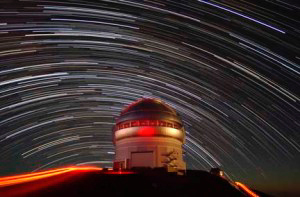Star dust to star dust, Volk never looked back
COFFEE WITH WARREN, with Warren Harbeck
Cochrane Eagle, August 17, 2005

Gemini North Observatory on Mauna Kea, Hawaii, is framed by southern star trails. Kevin Volk, originally from Cochrane, uses this telescope to study far-away dust to gain a better understanding of the universe. Photo courtesy of Gemini Observatory/AURA
Sometimes we're tempted to put ourselves down, thinking we're nothing more than a speck of dust, observed the late Franciscan astronomer Lucian Kemble. But remember this, he would say, "it's star dust."
Star dust – that's the stuff that gave me a great excuse for coffee the other day with a former Cochrane chap who specializes in the study of star dust – star dust in far-away parts of our universe, using one of the finest – and largest – publicly funded optical/infrared telescopes on earth.
Kevin Volk is a 1977 Cochrane High School graduate with a Ph.D. in physics and astronomy from the University of Calgary. He currently holds the position of Gemini Science Fellow at Gemini North.
Putting it simply, Kevin is among a handful of professional astronomers who have hands-on access to the 8.1 metre (26.6 ft.) Gemini telescope atop Mauna Kea volcano on the island of Hawaii.
A specialist in deep-space infrared astronomy, he's seeking at the moment to understand the unusual behavior of certain dust particles within "planetary nebulas," a term that has nothing to do with planets, but refers rather to the shell of gas emitted by some stars in their dying days. While much of such stars' mass is blown into space as dust by stellar winds, some star dust refuses to leave the neighbourhood. Kevin wants to know why, and the Gemini scope is a means toward finding the answer.
The Gemini North telescope is one of a pair of instruments with identical state-of-the-art mirrors. (Gemini South is in Chile.) They've been in the news a lot lately because of their role in identifying what is thought to be a 10th planet beyond the orbit of Pluto – the work of other astronomers at the Gemini observatories.
These telescopes are amazingly sharp, Kevin told me. In technical terms, they can resolve down to .4 arcseconds. (An arcsecond is 1/3600th degree.). What that means for most of us earthlings is that these scopes can distinguish a detail as small as the width of a dime as seen from 10 kilometres (six miles) away.
Gemini is an international partnership managed by the Association of Universities for Research in Astronomy under a cooperative agreement with the National Science Foundation of the United States. In addition to the U.S. and Canada, partners include the United Kingdom, Chile, Australia, Brazil and Argentina.
I asked Kevin what first attracted him to the serious study of the starry sky. At that moment his mother, Cochrane resident Maryel Volk, happened to enter the room with a warm-up on coffee. She had a ready answer:
"When he was in Grade 4, he was inspired by the U.S. space program," she said. At first he wanted to become an astronaut, but changed his mind and became an astronomer. He figured he had a better chance at reaching the stars through a big telescope than reaching the moon on a big spaceship.
From those early days, star dust to star dust, Kevin has never looked back.
© 2005 Warren Harbeck
JoinMe@coffeewithwarren.com